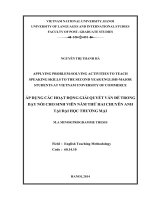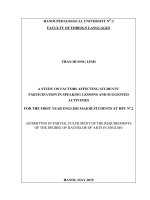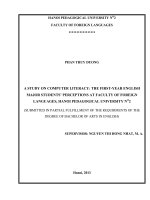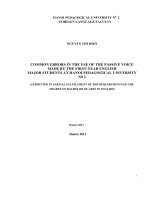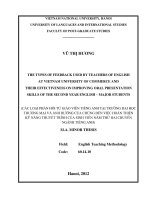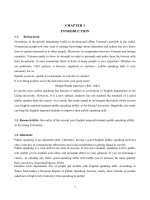The effectiveness of using youtube videos in listening comprehension for the second year english major students in foreign language faculty at HPU2
Bạn đang xem bản rút gọn của tài liệu. Xem và tải ngay bản đầy đủ của tài liệu tại đây (969.33 KB, 85 trang )
HANOI PEDAGOGICAL UNIVERSITY 2
FOREIGN LANGUAGES FACULTY
-----------------
ĐỖ THỊ CHỌN
THE EFFECTIVENESS OF USING YOUTUBE VIDEOS IN
LISTENING COMPREHENSION FOR THE SECOND
YEAR ENGLISH MAJOR STUDENTS IN FOREIGN
LANGUAGE FACULTY AT HPU2
(SUBMITTED IN PARTIAL FULFILLMENT OF THE REQUIREMENTS
OF THE DEGREE OF BACHELOR OF ARTS OF ENGLISH)
BA THESIS IN ENGLISH
HANOI, 2017
HANOI PEDAGOGICAL UNIVERSITY 2
FOREIGN LANGUAGES FACULTY
-----------------
ĐỖ THỊ CHỌN
THE EFFECTIVENESS OF USING YOUTUBE VIDEOS IN
LISTENING COMPREHENSION FOR THE SECOND YEAR
ENGLISH MAJOR STUDENTS IN FOREIGN LANGUAGE
FACULTY AT HPU2
(SUBMITTED IN PARTIAL FULFILLMENT OF THE REQUIREMENTS
OF THE DEGREE OF BACHELOR OF ARTS OF ENGLISH)
BA THESIS IN ENGLISH
SUPERVISOR: NGUYỄN THỊ HÀ ANH, MA
HANOI, 2017
ACKNOWLEDGEMENTS
For the completion of this thesis, I have received great assistance
and support from many people without whom the work could not have
been fulfilled.
First and foremost, I would like to express my sincere thanks to
my supervisor Mrs.Nguyen Thi Ha Anh, M.A.; I would love to show
profound gratitude to them for her scholarly instruction, critical
comments, great encouragement and valuable materials. Without these,
this thesis could have probably uncompleted.
I also would like to show my profound gratitude to all the
lectures at Hanoi Pedagogical University N.o2, especially the lectures
in the Foreign Language Faculty for the tirelessly devoting time and
efforts to enrich, broaden and deepen my knowledge over the past four
years.
Also, I am particularly grateful to the second year English majors
coming from Course 41 of Foreign Language Faculty, Hanoi
Pedagogical University N.o2 who help me a lot in completing the
surveys and participating the experimental research so that I can get the
data for my research.
Last but not least, I owe a debt of gratitude to my beloved
family, for their support, encouragement and love, which were
extremely important for the completion of this thesis.
STATEMENT OF AUTHORSHIP
Title:
THE EFFECTIVENESS OF USING YOUTUBE VIDEOS IN
LISTENING COMPREHENSION FOR THE SECOND YEAR
ENGLISH MAJOR STUDENTS IN FOREIGN LANGUAGE
FACULTY AT HPU2
(Graduation paper submitted in partial fulfillment of the Degree of
Bachelor of Arts in English)
I certify that no part of above report has been copied from any other
person‘s work without acknowledgements and that the reports is originally
written by me under instructions of my supervisor.
Date submitted: May 2017
Student
Supervisor
Do Thi Chon
Nguyen Thi Ha Anh,M.A.
LIST OF TABLES
Table 1: Students’ opinions whether listening is difficult to improve
Table 2: Students’ opinions about new techniques applying in listening
Table 3: Frequency of practicing listening
Table 4: Students’ attitudes towards using YouTube videos
i
LIST OF GRAPHS
Graph 1: The marks of two groups in pre-test
Graph 2: The average marks of two groups in pre-test
Group 3: The marks of two groups in post-test
Group 4: Average marks of two groups in post-test
Group 5: Compare the marks of two groups between pre-test and post-test
Graph 6: Students’ opinions whether listening skills is difficult
Graph 7: Students opinions about traditional ways of learning listening
Graph 8: Frequency of Internet use
Graph 9: The popular visited websites of students
Graph 10: Frequency of using YouTube website
Graph 11: YouTube for educational purposes
Graph 12: Common ways to practice listening
Graph 13: The benefit of educational YouTube
Graph 14: YouTube-source for practicing listening
Graph 15: Videos are better than audio sound recording
Graph 16: Videos as a Teaching Material
ii
LIST OF ABBREVIATIONS
HPU2: Hanoi Pedagogical University Number 2
EFL: English as Foreign Language
ICT: Information Communication Technology
OHP: Overhead projector
iii
ABSTRACT
This study investigates whether watching clips/videos from YouTube
enhances the second year English major students’ listening comprehension
and identify students' attitudes towards using YouTube videos in listening
comprehension. The population was 40 second-year students from the Course
41 at Foreign Language Faculty of Hanoi Pedagogical University No.2.
Participants were divided in two groups; one group is given the treatment
(watching YouTube videos) during five weeks and the results are gathered at
the end; the control group receives no treatment, over the same period of time,
but undergoes exactly the same tests. The main methodology using in study is
experimental research. Videos used in this study were chosen based on the
abilities and interesting of students and they were in various kinds of videos
in YouTube for students to practice. Clips and comprehension exercises were
introduced in classroom and they continue viewing at home. In addition, one
questionnaire was given at the end of the five-week project to determine
students' attitudes towards their experience in using the YouTube clips.
Results indicate overall positive attitudes and effectiveness towards using the
clips to supplement classroom instruction. The majority of students agreed
that watching English movie was very useful and that the clips helped them to
improve their listening skills and better understand vocabulary and phrases
used by native speakers.
iv
TABLE OF CONTENTS
PART ONE ................................................................................................... 1
INTRODUCTION ........................................................................................ 1
I. Reasonable of study ................................................................................. 1
II. Research questions ................................................................................. 3
III. Research objectives ............................................................................... 3
IV. Research scope ...................................................................................... 4
V. Research methods ................................................................................... 4
VI. Significance of the proposed research ................................................... 4
VI. Design of the research work .................................................................. 5
PART TWO ................................................................................................... 6
DEVELOPMENT .......................................................................................... 6
CHAPTER ONE ............................................................................................ 6
THEORETICAL BACKGROUP ................................................................... 6
I. Introduce to listening comprehension ....................................................... 6
1. Literature review in brief ........................................................................ 6
2. Definition of listening ............................................................................. 7
3. Listening comprehension......................................................................... 8
4. Process of listening comprehension ......................................................... 9
4.1. Bottom-up processing........................................................................ 9
4.2. Top-down processing ...................................................................... 10
v
5. Listening stages ..................................................................................... 11
5.1. Pre-listening stage ........................................................................... 11
5.2. While-listening stage ....................................................................... 12
5.3. Post-listening stage .......................................................................... 13
6. Some factors affect listening comprehension ......................................... 14
6.1. The listeners .................................................................................... 14
6.2. The speakers .................................................................................... 16
6.3. The content...................................................................................... 17
6.4. Physical settings .............................................................................. 17
II. The employment of audio visual aids.................................................... 18
1. Audio Aids ............................................................................................ 18
1.1. Types of Audio Aids ....................................................................... 19
2. Visual Aids............................................................................................ 21
2.1. Types of visual aids ......................................................................... 21
III. Introduction YouTube ......................................................................... 23
1. An Overview of YouTube .................................................................... 23
2. The Value of YouTube .......................................................................... 23
3. Reasons for using YouTube in learning to listening .............................. 24
3.1. Cognitive reasons for the use of YouTube ....................................... 25
3.2. Affective reasons for the use of YouTube ....................................... 25
3.3. Authenticity reason for the use of YouTube .................................... 26
CHAPTER TWO ......................................................................................... 28
METHODOLOGY ....................................................................................... 28
vi
I. Research methods applying in the research ............................................ 28
1. Experimental research (the main research method)................................ 28
2. Survey questionnaires............................................................................ 28
II. Aims of using methodology .................................................................. 29
III. Participants .......................................................................................... 30
1. Principles of selecting participants ........................................................ 30
2. Construction of participants in experimental research ........................... 31
2.1. Experimental group. ........................................................................ 31
2.2. Control group. ................................................................................. 32
IV. Tests in study ...................................................................................... 32
1. Pre-test .................................................................................................. 32
2. Post- test............................................................................................... 32
3. Pre-test/Post-test control group design.................................................. 33
V. Procedures ............................................................................................ 34
1. Steps apply methodology ...................................................................... 34
1.1. Step One: Select a Research Topic .................................................. 34
1.2. Step Two: Review the Literature and Specify a Research Question . 34
1.3. Step three: Select and Assign Participants to Groups ....................... 35
1.4. Step four: Administer the pre-test to all subjects in both groups ...... 35
1.5. Step five: Administer Experimental Treatments .............................. 35
1.6. Step six: Administer the post-test to all subjects in both groups and
survey for experimental group ................................................................ 35
1.7. Step seven: Formulate Conclusions ................................................. 36
vii
2. Processes of experimental research ....................................................... 36
2.1. Week one ........................................................................................ 36
2.2. Week two ........................................................................................ 37
2.3. Week three ...................................................................................... 37
2.4. Week four ....................................................................................... 38
2.5. Week five ........................................................................................ 38
CHAPTER THREE ...................................................................................... 40
FINDING AND DISCUSSION .................................................................... 40
I. Experimental research ............................................................................ 40
1. Description ............................................................................................ 40
2. Discussion ............................................................................................. 43
II. Students’ questionnaire ..................................................................... 44
1. Attitude of students to listening skills .................................................... 44
1.1. Listening is a difficult skills ............................................................ 44
1.2. It is difficult to improve listening skills ........................................... 44
1.3. Practicing listening by using traditional ways is boring ................... 45
1.4. I want to be introduced some new techniques to be better in listening
............................................................................................................... 46
Table 2: Students’ opinions about new techniques applying in
listening ................................................................................................. 46
2. The learners ‘familiarity with the use of Internet ................................... 46
2.1. Frequency of using Internet ............................................................. 46
2.2. The visited websites of students ...................................................... 47
viii
2.3. Students’ frequency of using YouTube Website .............................. 48
2.4. YouTube website for educational purposes ..................................... 48
2.5. Students’ frequency and common ways of practicing listening ........ 49
3. Attitudes of students toward using YouTube videos in listening
comprehension .......................................................................................... 51
3.1. The benefit of Educational YouTube Videos in improving listening
comprehension ....................................................................................... 52
3.2. YouTube-source for practicing listening comprehension ................. 53
3.3. YouTube Videos are better than Audio Sound Recordings .............. 55
3.4. Videos as a Teaching Material ........................................................ 56
4. Discussion .......................................................................................... 57
PART THREE ............................................................................................. 60
CONCLUSION ............................................................................................ 60
LIMITATIONS ............................................................................................ 62
RECOMMENDATIONS ............................................................................. 64
REFERENCE ............................................................................................... 65
APPENDIX .................................................................................................. 68
APPENDIX ONE ........................................... Error! Bookmark not defined.
STUDENTS’ QUESTIONNAIRE ............................................................... 68
ix
PART ONE
INTRODUCTION
I. Reasonable of study
Nowadays, English language in the entire the world has become more
and more important. It is either the official language or an official
language in almost 60 states in the world and is the native language of
more than 350 million people. It is the most widely learned as second
language. English is the international language of difference fields such as
business, politics, science, technology, banking, tourism and other.
Therefore, English does not only become more popular but it is also a
main international language.
In Vietnam as well as in other countries, there is a great demand for
learning English, from young to old, from male to female alike. It cannot
deny that English plays a necessary role in Vietnam. Therefore, English is
a compulsory subject at the elementary level with the goal of providing
students with a basic knowledge of using English as a foreign language
and building on this knowledge at the junior and high school levels. At the
post-secondary level, English is a required subject for all majors.
However, in some universities, there are few opportunities for students to
use English in real life situations. As the results, there is lack of English
ability in spite of learning English for a long time. It is the challenge for
teachers of courses to improve students’ listening and speaking skills.
Listening skills which is one of four necessary skills plays a crucial role
in daily life, is the key skills used in communication. In the total time
people spend on communicating, listening takes up 40-50%; speaking 2530%; reading 11-16%; and writing about 9% (Gilakjani and Ahmadi,
1
2011) As for foreign language learning, listening is of paramount
importance because it provides the language input (Rost, 1994). Without
understanding input appropriately, learning simply cannot get any
improvement. Listening is very important because if you aren’t able to
hear, you won’t understand what other means so you cannot know how to
reply. Therefore, without comprehension spoken input, no communication
can be achieved (Cross, 1998).
In spite of that fact, it can be found that many students in universities
failed in practicing listening skills. Some of them complained that they felt
unconfident and nervous with listening tasks so they hardly understand the
content or spoken messages. The second year students who still lack of
experience and have no appreciate learning methods. Traditional ways are
listening to and repeating textbook CDs or recordings which may not be
interesting or realistic examples of communication. Teachers should find
other methods of listening that are typically attractive to students such as
listening to music and watching movies or videos. Watching carefully
chosen scenes and clips from English media can provide students with the
opportunity to become engaged in both a visual and audio representation
of real life situations with the natural vocabulary, phrases, slang, and
intonation used by native speakers. As students become interested in the
storylines and characters of what they are watching, their motivation to
learn English may develop. As scenes from English movies and TV series
are readily found internationally on YouTube, it was the aim of the
researcher to investigate a way to improve students’ listening skills. Both
teachers and students can use YouTube for uploading their personal videos
and watching others’ videos, and in the recent years, they have learned to
use it more and more productively in language learning and teaching.
2
YouTube is especially useful for classroom use, as it is full of authentic
material, which in turn has been proven to motivate students better than
school activities (Peacock, 1997)
YouTube is one of the most common video-sharing websites in the
Internet which is free, easy to access source of material that includes
ordinary people taking their videos in many aspects such as music, movies,
games as well as sports and education. So there are enormous amounts of
videos for English learning in general and for English listening
comprehension learning. It does not only provide leaners with the space to
practice and test their listening ability but also gives them the chance to
have opportunities of listening native English speakers and interacting
with them.
All these above reasons have inspired the writter to do research in
listening activities “The effectiveness of using YouTube videos in listening
comprehension for the second year English major students at Foreign
Language Faculty of HPU2.”
II. Research questions
Several principle questions are raised as follows:
1. How effective are YouTube videos in improving the students’
listening comprehension?
2. Which are the students’ attitudes towards using YouTube videos in
listening comprehension?
III. Research objectives
This study shows how the use of YouTube videos is very effective in
the area of English language learning and teaching considering the wide
spread of the Internet and the easiness of its use. In addition to that, it can
develop their comprehensive
listening through YouTube
3
videos;
furthermore, this research provides the proof to accept or deny the idea of
using YouTube videos as a means of helping the learners and teachers to
enhance the comprehensive listening of the learners.
1. To investigate whether watching clips/videos from English movies,
YouTube enhances the second year English major students’ listening
comprehension.
2. To find out what attitudes the second year English major students of
HPU2 have towards English listening through media clips/videos on
YouTube.
IV. Research scope
Within this study, the researcher only focuses the second year English
major students at Hanoi Pedagogical University No.2 to investigate the
attitudes and effectiveness that students have towards English listening
through media videos on YouTube and then give them some material
sources to practice and enhance students’ listening ability.
The population involved in this research is forty English major of
Course 41 of Foreign Language Faculty at Hanoi Pedagogical University
No.2
V. Research methods
1. Documents review
2. Experimental research
3. Survey questionnaires
VI. Significance of the proposed research
After the research, it is hoped that the result will be useful:
1. For the learner of English, the research provides students an effective
tool to overcome the difficulties and improve their listening skills- one
of the most importance and difficult skills.
4
2. For the teacher of English, this study gives the valuable and useful
information
on
new
effect
methods
of
teaching
listening
comprehension.
3. This research is also beneficial to anyone who is interested in listening
comprehension.
VI. Design of the research work
The research work has three main parts, namely: Introduction, Development
and Conclusion. The part of Development consists of three chapters
Chapter one is entitled “Theoretical background” which includes two
sections. Section one is about theoretical background of listening
comprehension: definition, stages in listening comprehension, the process
of listening comprehension, as well as the factors effect to listening. And
section two is the generalization about information and communication
technology (ICT) and YouTube.
Chapter two is named “Methodology” introduces the methods were
applied in the study: definition, aims, and procedure and participants of
methodology
Chapter three discuss and analysis the result of methodology
5
PART TWO
DEVELOPMENT
CHAPTER ONE
THEORETICAL BACKGROUP
I. Introduce to listening comprehension
1. Literature review in brief
The issues of teaching and learning English listening skills have been
researched by many researchers from all over the world. Using language to
interaction is a vital part of our daily lives and listening is an important factor
of this process and is comprised of a lots sub-skills. As Rost (1994)
determined that listening plays an important role in the second language
teaching for some reasons. In addition, Rost stated four principles for
developing listening ability for learners such as the necessity of using face to
face communication; focusing on meaning and trying to learn new and
important content; working on comprehension activities; and acknowledging
that listening is an internal process that cannot usually be directly observed
(Rost, 1991: 70). Anne Anderson and Tony Lynch (1988) showed another
point of view in listening: listening is not passive language skills it is active
one and the listener acts as active model builders. Yagang (1994) pointed out
reasons why listening is difficult come mainly from four following factors:
the message (content, linguistic features), the speaker, the listener and
physical settings. In Teaching Listening (1989) Mary Underwood gave a clear
description about spoken language; she introduced three stages of listening
comprehension: pre-listening, while-listening and post-listening stage and
focus seven potential difficulties in learning English listening. According
6
Michael Berman (2003) there are some listening strategies to improve the
effectiveness in listening.
Finally, several researchers have found out some additional factors to be
considered when designing lessons for the development of listening skills for
the second language learners. Most of them are related to the special
characteristics of spoken language such as colloquial language, idioms, slang,
reduced forms, and shared cultural knowledge (Dunkel, 1991; Ur, 1984). In
addition, the learners’ perception that the natives speak too quickly can block
comprehension. Students need to be exposed to language delivered at varying
rates and speeds in a natural context without pauses (Brown, 1994).
2. Definition of listening
There are many distinct definitions of listening, and there is little
agreement about which is the best. Each definition represents a different
perspective of listening, and with a lot of approaches to listening there is
bound to be a number of definitions.
Bulletin (1952) identified that listening is one of the basic language
skills. It is a medium through which children, the young and adults gain a
huge portion of their education, information, understanding of the world and
of human affairs, their ideals, sense of values, and appreciation. So listening
plays an important role in receiving knowledge of every people.
According to Howatt and Dakin (1974) listening is ability to identify and
understand what people are saying. This process involves understanding the
speakers’ accent and pronunciation, their grammar and vocabulary; and
comprehension of meaning. An able listener is capable of doing these things
at once.
In addition, Lesley Barker (2001) defined listening is not only the ability
to hear and understand what others say but also it is skills involving a good
7
manners, asking for clarification, showing empathy an providing an
appropriate response.
Listening is considered one of the most important processes of the oral
communication. Rubin (1991) pointed out that listening as “the active and
dynamic process of attending, perceiving, interpreting, remembering and
responding to the expressed verbal and non-verbal needs, concerns and
information offered by the human beings”. This definition is more specific,
emphasizing the need for attention, perceiving and interpreting and
remembering. In addition, it focuses our attention on the all needs and
concerns of real people
In conclusion, listening is an active process, involving mind and body,
with verbal and non-verbal processes working together, and listening allows
us to be receptive to the needs, concerns, and information of others, as well as
the environment around us. It is an important skills so people need to practice
and acquire skills to be good listeners
3. Listening comprehension
Recently, listening comprehension became a matter of a huge
importance after it was only a casual and a shallow subject to be thought of.
According to Gary Buck, he defined that listening comprehension is an active
process of constructing. He concluded, “Comprehension is affected by a wide
range of variables and that potentially any characteristic of the speaker, the
situation or the listener can affect the comprehension of the message”. In
other words, comprehension of a spoken message can either be isolated word
recognition within the sound stream, phrase or formula recognition, clause or
sentence, and extended speech comprehension. Littlewood (1981) also show
the same point of view to Gary Buck. He determines that the listening
demands active involvement from the hearer. To construct the message that
8
the speaker intends, the hearer must actively contribute knowledge from both
linguistic and nonlinguistic sources.
Anderson and Lynch (1995) had different viewpoint. They defined the
listener as active model builder. They said that in order for successful
listening they have to construct own “coherent interpretation” of any spoken
message.
Rost (2002) considered listening comprehension is an inferential
process. It means that linguistic knowledge and world knowledge interact as
listeners create a mental representation of what they hear. There are two
processes which are bottom up and top down processes. They are applied to
get to this mental representation and achieve comprehension.
To sum up, in order to be successful in listening, we need to remember
that listening comprehension is not a simple skills which can be mastered
once and for all and then did not pay attention then ignore while other skills
are developed. It must be daily practiced with increasingly difficult material.”
(Rivers Wilga, M., 1986)
4. Process of listening comprehension
Considering how the listeners process input, researchers have classified
listening process into two types: bottom-up processing and top-down
processing (Buck, 1994).
4.1. Bottom-up processing
According David Nunan (1999), bottom-up processing is a process in
which listener try to make sense of what we hear by pay attention on several
parts: the vocabulary, the grammar and functional phrases, sound, etc. In
other words, the listener tends to divide the speaker’s speech into small
constituents to understand what is said.
9
In addition, Richards and Renandya (2000) explained the bottom-up
processing in an analytical way and affirmed that the bottom-up processing
model assumes that listening is a process of decoding the sounds that one
hears in a linear fashion, from the smallest meaningful units (phonemes) to
complete texts. From to this view, phonemic units are decoded and linked
together to form words, words are linked together to form phrases, phrases are
linked together to form utterances, and utterances are linked together to form
complete meaningful texts, so meaning is arrived at as the last step in the
process. Therefore,
the bottom-up processing functions by breaking the
speech into small units and then gathering them piece by piece and move
from this level to another level until those small pieces form a text or a speech
that is meaningful.
4.2. Top-down processing
Batova(2013) pointed out top-down process that “Emphasizing the
listener’s use of their existing knowledge of a topic and the relevant context
in forming hypotheses as to the speaker’s meaning and, when appropriate, in
modifying them to match new
input
information”. In other words, the
listener bases on his/her prior knowledge so as to comprehend what the
speaker is saying, or at least have a general identification of the topic and
modify his prior knowledge to fit the new input. The role of the background
knowledge is central to the way listener understand the spoken passage
whether through listening or reading.
According to Richards and Renandya (2000) the top-down processing is
that the listener actively recreates the meaning of the speaker’s utterance and
uses the sounds as stimuli to waken his/her prior knowledge and understand
the input utterances, they state that “In this reconstruction process, the listener
10
uses prior knowledge of the context and situation within which the listener
takes place to make sense of what he/ she hears”. Therefore, the knowledge
that the listener owning in his memory plays a major role in understanding the
speaker ‘massage.
This processing refers to use of background knowledge in understanding
the meaning of the message. Background knowledge consists of context, that
is, the situation and topic, and co-text or physical environment, in other
words, it means what came from and before.
In conclusion, Flowerdew and Miller suggest that the beginners need to
work on their bottom-up basics and develop their skills of decoding the
language units, whereas the learners who have more advanced level, and are
good at phonology and syntax, it is better for them to develop their top-down
skills because of the more appropriate without forgetting that the bottom-up
skills are required even in advanced levels like in fast speech (Flowerdew &
Miller, 2005).This means that in spite of their differences in terms
function, they
of
are both necessary for the learners in their process of
developing their listening comprehension.
5. Listening stages
Mary Underwood
(1989) introduces
three
stages
of listening
comprehension: pre-listening, while-listening and post-listening stage.
5.1. Pre-listening stage
Pre-listening stage is the stage in which students prepare for listening
task. It cannot deny that learners will find it difficult to do a listening lesson,
when they don’t have any ideas of what they are going to hear. Even if the
sounds or the words which they hear are familiar, they may still be unable to
understand because of lack certain knowledge of the topic, the setting or the
11
relationship between the speakers. Thus, teachers need to help their students
to arouse their expectations and know the purposes before a listening lesson.
This kind of work is described as “pre-listening activities”.
Its aims are not only to introduce the topic they may be setting the
context, generating listeners ‘interest, activating current knowledge and
language which related to the listening as well, predicting the content,
understanding the listening tasks. Pre-listening activities may expose students
something but not too much, about little content of the passage by mentioning
some information, vocabulary about the topic.
In conclusion, the pre-listening activities play important role in helping
students partially understand about the content of the massage. As Penny Ur
affirms that “It would seem a good idea when presenting a listening passage
in class to give students some information about the content, situation and
speakers before they actually start listening.” (1992, P.4)
5.2. While-listening stage
The while-listening stage involves activities that students are asked to do
during the time that they are listening the text. The purpose of while-listening
activities is to help learners develop the skills of eliciting messages from
spoken language.
This stage helps students learn to recognize how the language sounds in
term of pronunciation of words, the stress, the rhythm, the intonation that they
can use what they hear as a model for their own speech.
According Mary Underwood (1989) recommend some while-listening
activities:
Marking/checking items in pictures
12

